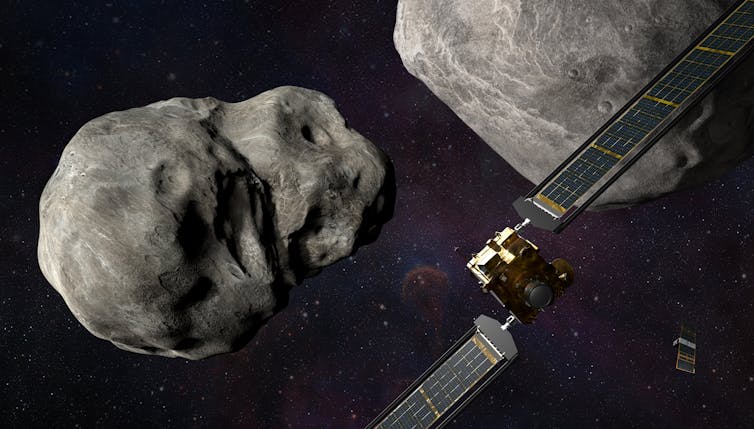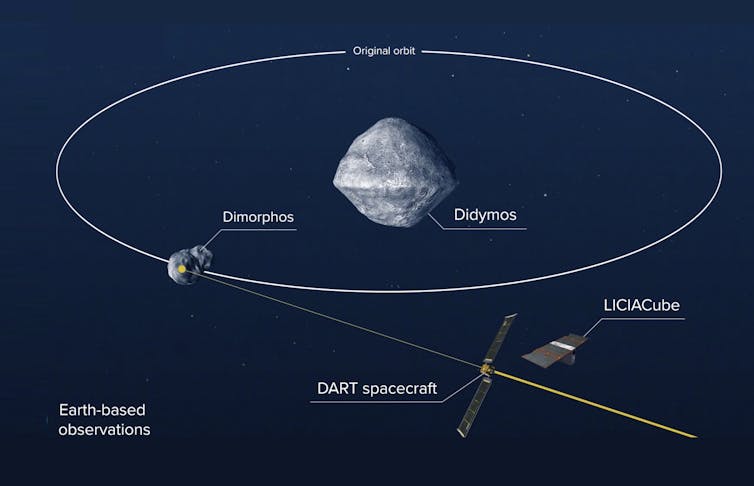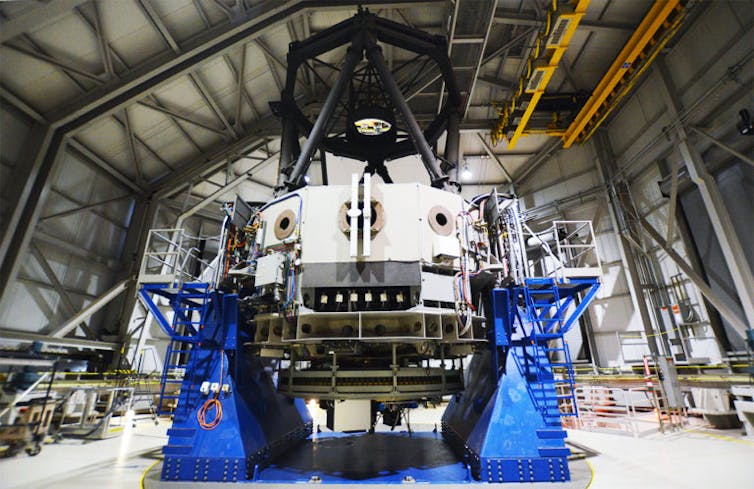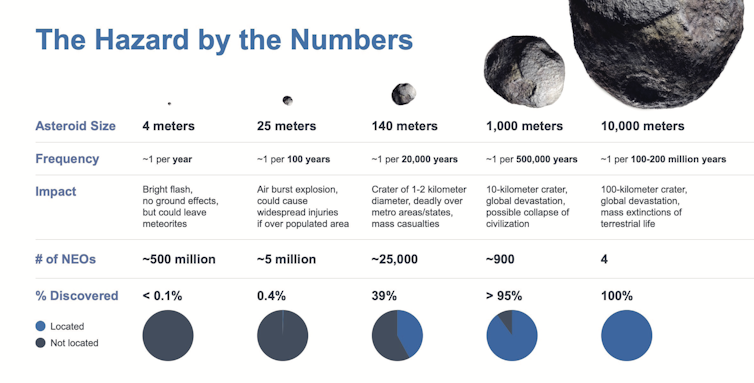
Illustration of DART before influence.
NASA/Johns Hopkins APL/Steve Gribben
On September 26 at 11.15pm UTC, NASA’s DART mission (Double Asteroid Redirection Test) will be the initial to deliberately and measurably change the movement of a significant system in our Photo voltaic Procedure. In other terms, it will smash into an asteroid.
The mission will give the first check of a technique that could be applied in the foreseeable future – to redirect any asteroids we detect on a collision course with Earth.
A binary pair of area rocks
DART was launched on November 24, 2021, its destination a pair of asteroids in orbit about every other, 11 million kilometres from Earth.
The more substantial asteroid in the pair is named Didymos and is 780 metres in diameter. The lesser asteroid, just 160 metres large, is identified as Dimorphos. The two orbit every single other at a distance of 1.18 kilometres, and 1 orbit usually takes shut to 12 hours.

NASA/Johns Hopkins APL
These asteroids pose no risk to Earth and have been preferred as the goal for DART partly due to that truth. But also, importantly, simply because the asteroids type a binary pair, it will be doable for astronomers on Earth to evaluate the benefits of the effects.
As the asteroids orbit each other, the sunlight reflected off them will increase and decreases, varying systematically over the 12-hour cycle of the orbit. Astronomers making use of powerful telescopes from Earth can monitor this variation and see how it alterations, from before to right after the collision.
![]()
The physics is easy, the mission is not
The physics appears easy, and it is. Hit a person detail with a further factor to transform its motion. But the mission execution is quite difficult. When DART reaches the asteroids, it will be 11 million kilometres from Earth after a 10 month journey. The spacecraft has to use autonomous targeting, utilizing pictures of the asteroids it acquires as it methods.
DART requires to recognise the asteroids by by itself, mechanically lock onto Dimorphos, and alter its trajectory to hit it. This is all even though going at a velocity of practically 24,000 kilometres per hour!
The benefits of the impact, even though moderately straightforward to measure, are hard to forecast. The measurement, condition, and composition of Dimorphos, and exactly in which DART hits and how hard, will have an affect on the end result.
All these variables are uncertain to some degree. Comprehensive computer system simulations of the effects have been carried out, and the comparisons of the simulations, predictions, and measured success will be the principal results of the DART mission.
As very well as the measurements from telescopes on Earth, an up-close see of the impression alone will be probable, from an Italian Area Agency CubeSat (a modest type of satellite) termed LICIACube that was deployed from a spring-loaded box aboard the craft on 11 September. LICIACube will comply with together and photograph the collision and its aftermath.

Lowell Observatory
The outcomes will tell us a good deal about the character of asteroids and our potential to modify their motions. In the potential, this expertise could be applied to prepare planetary defence missions that find to redirect asteroids deemed to be a danger to the Earth.
What is the level of threat?
An asteroid as tiny as 25 metres in diameter could create accidents from an airburst explosion if it strike the ambiance more than a populated location. It is approximated that 5 million these objects exist in our Solar System and that we have identified around .4% of them. These types of a strike is estimated to take place as soon as each 100 several years. Whilst fairly repeated, the overall chance is low and the effects threat is relatively low much too.
However, it is predicted there are 25,000 objects in the Photo voltaic Procedure the sizing of Dimorphos, 39% of which are acknowledged, that hit Earth each 20,000 decades. This kind of an item would bring about mass casualties if it strike a populated space.

NASA
Asteroids that could obstacle the existence of human civilisation are in the 1 km as well as size classification, of which there are fewer than a thousand in the Solar Procedure they could hit Earth only every 500,000 a long time. We have by now identified 95% of these objects.
So, prospective asteroid collisions with Earth range from the recurrent but benign to the really exceptional but catastrophic. The DART tests are becoming carried out in a really related and intriguing measurement assortment for asteroids: those increased than 100 metres.
If DART is prosperous, it could set the scene for long run missions that goal asteroids, to nudge them out of the way of collisions with Earth. When an asteroid is a long way from Earth, only a compact nudge is essential to get it out of our way, so the previously we can determine asteroids that are a potential threat, the better.
In the in close proximity to future, the nicely-worn premise of so several “an asteroid is coming, we have to have to deflect it!” flicks may effectively become a fact.
Steven Tingay, John Curtin Distinguished Professor (Radio Astronomy), Curtin University
This article is republished from The Discussion below a Imaginative Commons license. Go through the original report.







More Stories
Future of UDF in Kerala – Unraveling Kerala’s Political System
The Sociologic Of Political Silence: Explaining A Discourse In Jamaica’s Society
Harappan Civilizations Describe Indian Geography and Indian Politics